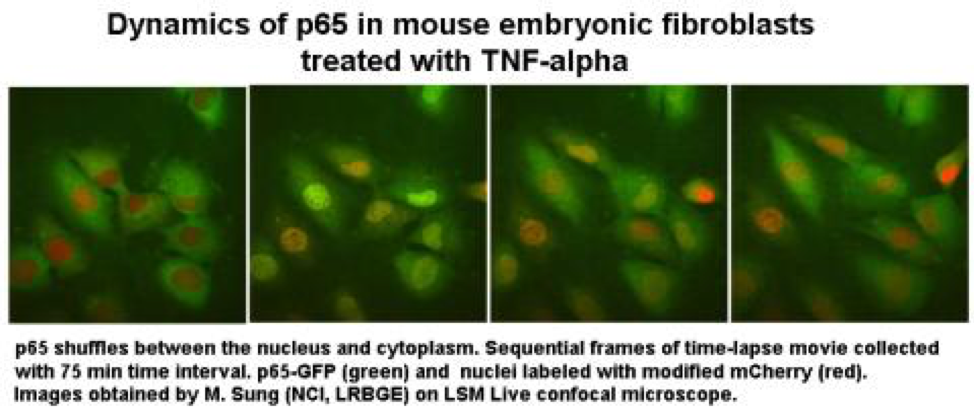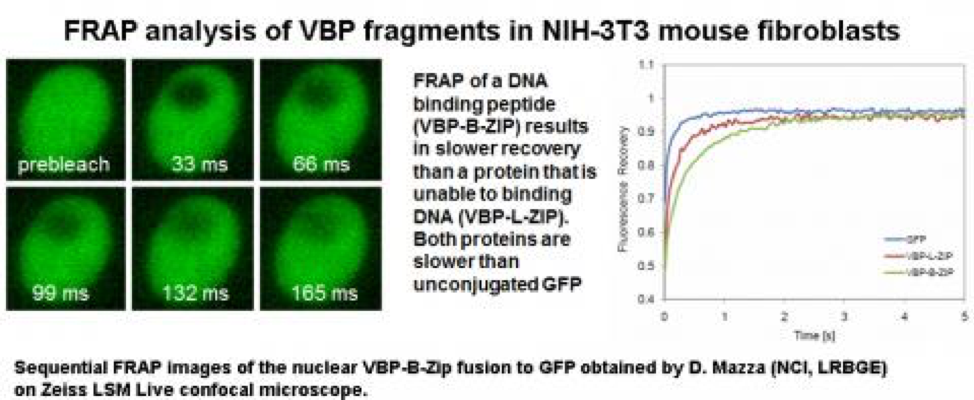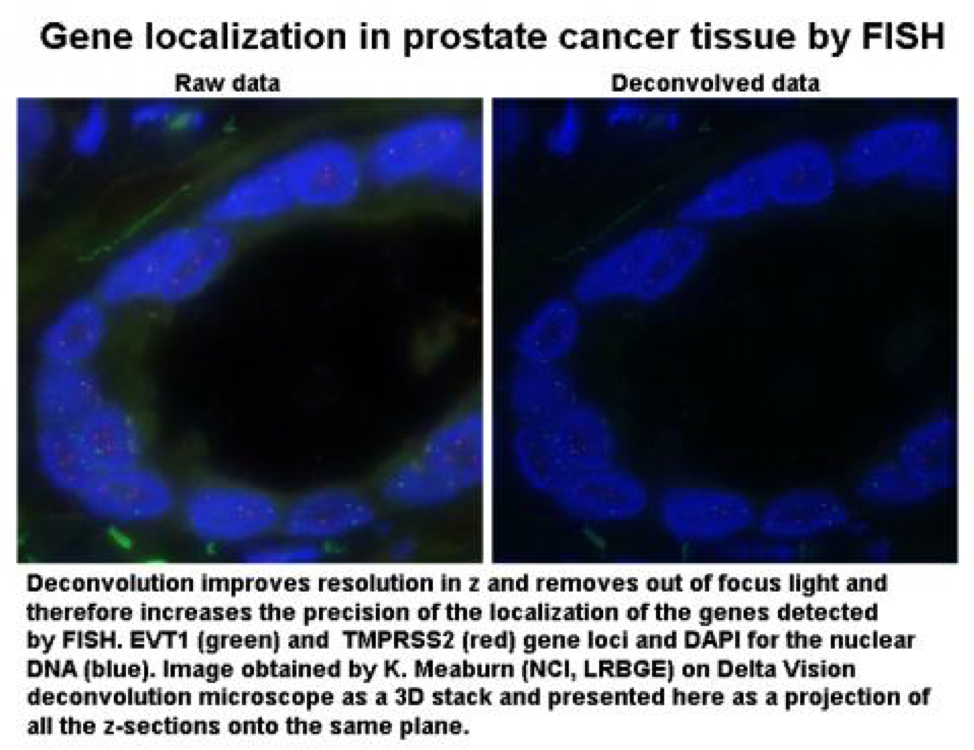Home
Instrumentation
Policies
Publications
Software
Image Aquisition
Images are acquired on imaging systems controlled by acquisition software often specifically designed for the appropriate microscope. In our Core images are acquired by the following software packages: Softworx (Delta Vision Elite), ZEN (Zeiss confocal microscopes), or Micro-Manager Open Source Microscopy Software (Custom SMT).
Image Processing
The next step, the most important for the scientist, includes image processing (deconvolution, filtering, scaling from 16-bit to 8-bit notation) and measurements for quantification of protein content, FRAP, and FRET. These are achieved on dedicated workstations of the core, utilizing the SoftWorx program (deconvolution), ZEN software (FRET algorithms for sensitized emission and acceptor photobleaching; and FRAP quantification), Metamorph (brightness quantification).
Image Conversion
Finally, images may be converted to movies (Quick Time and AVI) on workstations of the Core. Surface rendering is available from Imaris, Arrivis. Deconvolution may be performed by SoftWorx or Huygens. Final preparation of images for publication using programs such as Photoshop or Powerpoint should be done by the user in their own laboratory.
Standard Techniques
Muticolor Imaging
Fluorescence imaging is used for protein localization and colocalization in 3D. We can obtain 3D images of cells by collecting a series of images from different focal planes through the specimen. These images contain out-of-focus light which reduces contrast and introduces blur, but the out-of-focus light can be reduced by using either confocal microscopy or deconvolution microscopy. Multi-color imaging is necessary to observe colocalization of several proteins in the same cell. Many fluorescent proteins are now available for multi-color labeling and imaging of three to four different fluorophores is possible on most of our microscopes. One of our microscopes (Leica FISH) enables imaging in up to seven colors. More colors may be resolved by spectral unmixing using our LSM 510 confocal microscope (if we have this here, we should list it below under the Meta). Spectral unmixing is based on an analysis of the optical spectra of different fluorophores. It allows discriminating dyes or fluorescent proteins with similar spectra, such as GFP and YFP. However, this technique has its limitations. If different labels in the specimen are vastly different in intensity, the linear unmixing will not work properly.
Advanced Techniques
Time Lapse
Live imaging of cells and tissues tagged with fluorescent markers provides a much deeper understanding of cellular processes than imaging of a fixed specimen, since live cell imaging permits analysis of the dynamics of biological processes. We have performed many different time-lapse experiments in our core. These typically investigate changes in fluorescently tagged protein localization over time, such as movement of a protein from the cytoplasm to the nucleus. We have environmental chambers that regulate temperature and CO2 on the microscope stage. We use the Deltavision or Zeiss LSM 5 Live microscopes for time lapse studies. Both have sensitive cameras that reduce the amount of light exposure to the specimen.

FRAP (Fluorescence Recovery After Photobleaching) and FCS (Fluorescence Correlation Spectroscopy)
FRAP and FCS allow one to monitor and quantify the movement of tagged proteins. In FRAP the molecules contained in a specific region are “turned off” by means of photobleaching. If molecules are free to move, the exchange between bleached and non-bleached molecules results in the recovery of fluorescence within the region. The recovery data can be analyzed to provide information about the diffusion and binding rates of the tagged protein. Fast-scanning confocal microscopes such as the LSM 510 or LSM 5 Live can be used to apply FRAP to monitor fast protein kinetics.

FRET (Fluorescence Resonance Energy Transfer)
FRET is a technique to detect protein interaction and the formation of complexes between different proteins tagged with fluorescence markers. It also can be used to detect enzymatic activity by special reporters (FRET biosensors). In our core we have applied and further developed several different approaches for detection of FRET. We have performed FRET by either acceptor photobleaching or sensitized emission on a conventional confocal microscope. We used a conventional wide-field fluorescence microscope to perform FRET dynamics in studies of enzymatic activity with biosensors.

Photoactivated localization microscopy (PALM)
Photoactivated localization microscopy (PALM) is a Super Resolution (SR) technique based on the photoactivation of photoconvertable fluorescent molecules fused to the protein of interest. Most of those molecules are in inactive state and only a fraction of those are sequentially photoactivated by a short pulse of violet light. The precise position of the center of the signal emitted by each single molecule is calculated. The PALM image is a composite of all the single molecule coordinates. Expected spatial resolution is 20-50 nm in XY and 50 nm in Z. 3D version of PALM achieved in Zeiss Elyra instrument by double-helix ramp allows 3d imaging of a 1.4 um optical slice. This process is recommended for the fixed specimens. Dyes and color combinations are limited. Application of PALM to live imaging is limited by necessity of obtaining thousands of sequential time-lapse frames to obtain one image.
Structured illumination (SIM)
Structured illumination (SIM) is a Super Resolution (SR) technique based on imaging of a set of images from the same focal plane with a shifting grid pattern. Information is extracted from the raw data to produce a reconstructed image having a lateral resolution of 100 nm (approximately twice that of conventional confocals and wide-field instruments) and an axial resolution ranging between 150 and 300 nanometers. Among the advantages of SIM are the abundance of dyes and fluorescent proteins for labeling specimens and the ease of conducting multicolor imaging. Acquisition is moderately slow but still acceptable for live imaging. Images are post-processed in batches to compensate for the length of processing time (~ 5 min for a full frame).
Deconvolution
Deconvolution is a computational approach to remove out of focus light from 3D images. It is an alternative to confocal microscopy which removes out of focus light optically. In many cases, particularly with dimmer or light-sensitive specimens, deconvolved images are superior to confocal images, at least in part because more sensitive cameras can be used on deconvolution microscopes. In our core we have a dedicated optical sectioning microscope (Delta Vision) that utilizes commercially available software by a constrained iterative algorithm that progressively removes more and more out-of-focus light.

